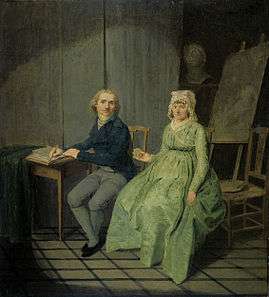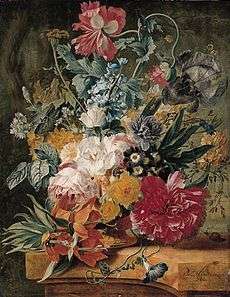Wybrand Hendricks

Wybrand Hendriks (June 24, 1744, Amsterdam – January 28, 1831, Haarlem), was a Dutch painter and the concierge of the Teylers Museum. He is primarily known because of his portraits.
Biography
Wybrand Hendriks was born in a sculptor family, as the son of the sculptor Hendrik Hendriksz (ca. 1704-1782) and his wife Aaltje Claasdr. Both his brothers (Hendrik jr. and Frans) followed in the foot steps of their father, and became sculptors as well. His only sister, Cornelia, married the sculptor Rijk Rijke.
According to the Netherlands Institute for Art History he learned to paint while working for the decorative wall paper factory of Johannes Remmers in Amsterdam.[1] In 1772 he purchased a wall paper company from Anthony Palthe, son of Gerhard Jan Palthe. In 1775 he married Palthe's widow, Agatha Ketel, who he drew in mourning clothes in 1773.[2]

A painting he later made in 1791 of her sitting across from him at a table (probably situated in the fundatiehuis) was purchased for Teylers Museum with support from the Vereniging Rembrandt in 1999.[3] In the year he married, he made a trip to England and Belgium.
In the 1780s he served a five-year term as one of the directors of the Haarlemse Tekenacademie (Haarlem drawing academy). From 1786 to 1819 he was the concierge ("kastelein") of the Teyler's Stichting in Haarlem, and he lived at the "Fundatiehuis" as curator of the art collection.
He assumed the position in 1785 after his predecessor Vincent Jansz van der Vinne had left in disagreement with Martin van Marum, the head of the fossil and instrument collections.[4] He maintained and restored the pieces in the collection as well. He maintained a studio in the old drawing room of Teyler's drawing academy, which had been moved to the city hall. As curator, he was responsible for expanding the collection of art, and for that he participated in auctions throughout the Netherlands to purchase drawings. Through Willem Anne Lestevenon he managed to purchase an important collection of 1700 Italian drawings from the collection of Queen Christina of Sweden in 1790 (the Odescalchi collection). This collection includes works by Michelangelo and Raphael, which are currently amongst the most important and valuable pieces in the Teylers Museum art collection.[4]
After his wife Agatha Ketel died in 1802, he remarried Geertruid Harmsen in 1806. She was the widow of J.Radecker, the city organist of Haarlem. She died in 1817. Two years later he moved to a house at the Oude Gracht, where he lived until he died in 1831 at the great age of 86. Hendriks was active as regent of the Vrouwe- en Antony Gasthuis hofje, member of the Haarlem city council and was a patriotic supporter of the French revolution at the end of the 19th century.
His registered pupils were Hermanus van Brussel, Warnaar Horstink, Gerrit Johan van Leeuwen, Hendrina Alida Sollewijn, Abraham Vallenduuk, and Jacobus Vrijmoet.
Works
He is known for portraits, landscapes, and copies after older masters, such as flower still lifes in the manner of Jan van Huysum.[1] Hendriks created several paintings in and around the Teylers Museum, for example of the directors of the Teylers Stichting, the Oval Room and the inner garden of the Foundation House. His paintings of the inner garden of the Foundation House and the Oval Room seem to have been created with the help of convex mirrors and other optical aids because the perspectives are impossible to get without.
He created portraits of, amongst others, Jacob van der Vos sr., Christiaan Scholten, Christiaan van Orsoy, Jan Petrus Scholten van Aschat, Frederik Alexander Vernède, Wernerus Köhne, Adriaan van der Willigen and Martinus van Marum. He also made grisailles, like the one presented here. This grisaille now adorns a fireplace in the Frans Hals Museum in one of the regent's rooms of the Oude mannenhuis. The subject is taken from the marble sculpture in the garden of the Fundatiehuis.
- Selected pictures
 Group portrait of the four chief commissioners of the ports, quays and cranes in Amsterdam, sitting around a table
Group portrait of the four chief commissioners of the ports, quays and cranes in Amsterdam, sitting around a table Wybrand Hendriks and Agatha Ketel
Wybrand Hendriks and Agatha Ketel Portrait of Colonel Cornelis Backer after Pieter Claesz Soutman's 1642 schutterstuk. The man resembles Hendriks himself
Portrait of Colonel Cornelis Backer after Pieter Claesz Soutman's 1642 schutterstuk. The man resembles Hendriks himself Vase of flowers after Jan van Huysum
Vase of flowers after Jan van Huysum Landscape
Landscape The Board of Teylers Foundation, 1786.
The Board of Teylers Foundation, 1786.
References
- 1 2 Wybrand Hendriks in the RKD
- ↑ Artikel van het Teylers: "Het portret van Wybrand Hendriks en zijn echtgenote Agatha Ketel"
- ↑ Portrait of the couple on Vereniging Rembrandt
- 1 2 Biographical entry on Wybrand Hendriks on Teylers website
External links
| Wikimedia Commons has media related to Wybrand Hendriks. |